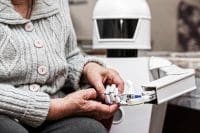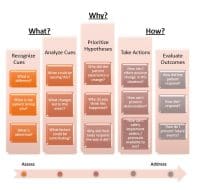For the 10 years of my nursing career that I spent in the acute care setting, patient turn around was very rapid. There wasn’t enough time to get to know patients on a personal level. That changed when I started working in a nursing home. Care in a nursing home is more personal. Patients, whom we refer to as residents, typically stay on a long-term basis, so you get to know their complete medical and nursing history, activities of daily living, preferences, diets, and behaviors in detail. In addition to necessary care requirements, you get to know the resident on a much more personal level. The residents tell you their past stories of success and failures. They offer you great wisdom and advice. You get to know their family and their relationships. I often treat them not only as a resident but as a family member.
A day in the nursing home: then
Let’s take a look at how care in the nursing home was delivered several years ago.
The nursing team in the nursing home usually consists of one RN, two licensed practical nurses, and eight certified nursing assistants to care for 80 residents. A typical day starts by waking the residents for morning care. Nurse assistants help them with bathing, grooming, dressing, toileting, and personal hygiene.
Once the resident is ready, the assistants take residents to the dining hall for breakfast. The residents sit in their designated, assigned seats waiting for an assistant to bring their trays. The television is switched on for their daily news. As time goes by, the dining hall starts becoming full of residents. They eat, socialize with their roommates, watch the news, or read the newspaper.
After breakfast, some of the residents remain in the hall for recreational activities. Some residents meet their therapist to do their rehabilitation programs such as physical, occupational and speech therapy. Licensed practical nurses start distributing medication after breakfast; residents line up to receive their regular scheduled medications.
Around noon, all the residents are back in the dining hall to have their lunch. After lunch, the same routine occurs—residents are engaged in either recreational or rehabilitative service. The nurses continue to dispense medication and do their treatments. Most of the residents in the long-term care are medically stable. Elderly living alone, or the family is unable to provide their needs are the common reasons for admission. Typically, residents usually require limited to extensive assistance in their activities of daily living.
A day in the nursing home: now
We still admit older patients who require skilled nursing assistance in the nursing home. However, now residents have more medically complex conditions such as heart failure, chronic obstructive pulmonary disease, or gastrointestinal bleeding, or they may have had a stroke or are terminally ill.
As a result, nursing skill requirements have increased. The nursing care we perform includes administration of medications usually via the oral, intramuscular, or subcutaneous route; wound dressings; feeding tubes; nebulization; and care plans. The weekly vital signs monitoring has become every 1 to 4 hours, and some physicians are ordering safety monitoring every 30 minutes.
There have been many cases of a patient on a ventilator who requires frequent suctioning, tracheostomy care, continuous oxygen monitoring, and sometimes CPAP and BiPAP devices are ordered. Furthermore, intravenous administration of medication has become the trend. RNs are ordered by the physician into draw blood and run laboratory tests such as iSTAT.
The increasing complexity and acuity of residents in the nursing home are becoming a challenge, especially when there are relatively few RNs who are trained to handle these complex patients.
Call to action
The changing environment in the nursing home makes the working condition difficult for nurses. Increased workloads, inadequate staffing, highstaff turnover, improper delegation of task between RN and LPN, and high-stress level among staff are some of the challenges faced by nurses in the long-term care. These challenges too often lead to poor quality of nursing care for the residents.
With the increasing complexity of residents and increase in admittance of terminally ill patients sent to nursing homes from the hospital, nursing home services need to transform. Nursing administrators must ensure that resources are available and the staff is adequately prepared to provide such complex care services.
Long-termcare nurses need to advocate for our residents and to ourselves to start the discussion about this issue to enforce policy and regulatory changes that govern long-term care. Our voice needs to be collectively heard. Nurses in specialties other than long-term care can support us in this effort.
Amil Tan is a nurse manager at the Riverside Premier Rehabilitation and Healing Center in New York City, New York.



















4 Comments.
Your posts are always amazing you have explain each and everything so clearly. thank you so much for this piece of information.
yes you are right nursing homes are also changing with time they are becoming more addvance and staff is putting more efforts for patients. with time it becomes people now have more options to choose the best between all.
I agree all skilled care has moved to the nursing home and staff ratios have not changed to meet the acuity of residents.
Lovely article, but in no way truly reflects most nursing homes.
Nurses and aides are so understaffed that they don’t have time to do but part of their own job, let alone help each other. Aide to patient ratio in Indiana allows up to (at least) 20 patients for ONE aide!
No getting to know anyone or their daily needs, let alone what their prior life was like IE; what they did for a living, who their friends were, etc.
This country needs a SERIOUS overhaul on nursing homes and FAST before the baby boomers get seriously elderly!